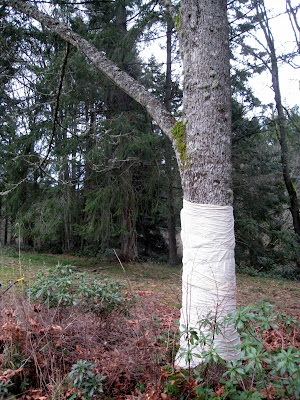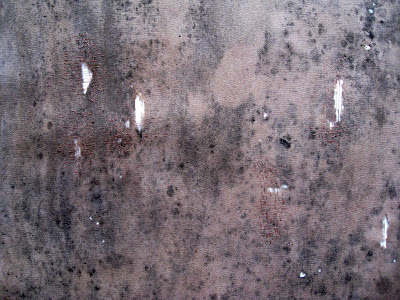A journal where I share my adventures developing a food forest based on permaculture principles. I also share my love of knitting here. For my life as a textile artist follow me at lesleyturnerart.com
Friday, March 30, 2012
Thursday, March 29, 2012
Adding My Staining to Tree Cloths

I am at the stage in my dialogue with the trees where it is my turn to respond. I need to make a mark reflecting the development of my relationship with these trees. I sampled dyeing with a Cedar branch extraction but wasn't enamoured with the colour nor the overall even covering of the tree's marks. Next I sampled more textural dyed marks using Procion MX colours.
Wednesday, March 28, 2012
Making My Mark on the Tree Cloths
After noticing Cedar stems left a print on cotton, I decided to make a dye with them. I collected windfall branches, cut them into small pieces....
...brought them to a boil, simmered for 2 hours then left the pot to cool overnight. I poured off the liquid as the 1st extraction and repeated the process twice more, making 2nd and 3rd extractions.
I dyed 2 sea-water, pre-mordanted cloths in the 1st extraction with a copper simultaneous-mordant. The cloth on the left had an ammonia post-mordant.
These 2 cloths had ash water pre-mordant with a copper simultaneous-mordant. The left hand cloth had an ammonia post-mordant. The results were a yellow-orange colour with the ammonia post-mordant shifting the colour more towards an orange. Interesting results but i wasn't enamoured with the colour. Even though the dye was made with material from the same tree that made the 1st stains, I couldn't see a connection between the two.
Tuesday, March 27, 2012
Eco-printing on Tree Cloths

I tore off pieces of the Cedar tree cloth and soaked them in a number of different pre-mordants,
sea water...
Monday, March 26, 2012
My Turn to Respond

The tree cloths were inside, now it was my turn to respond in this ongoing dialogue. Perhaps I could add more marks on the cloths using materials from each tree. I needed to test each tree's dye/stain potential so used India Flint's eco-printing technique of tightly wrapping material with cloth and steaming it.
Wednesday, March 14, 2012
Tree Cloths Removed
Thursday, March 8, 2012
Staining on Tree Cloths

In the darkness under the Cedar tree its cloth stayed wet and had decayed more rapidly than the others.

over the summer and fall I had continued with other dialogues within the Douglas-fir ecosystem. I laid a piece of cloth on the ground and left the leaves and debris fall on it. Each week I would uncover a corner, cut off a piece and bring it inside.
Tuesday, March 6, 2012
Tree Cloths
Within a few weeks, the cloth wrapped around the Cedar was rearranged by fauna running up and down the sloping trunk. I didn't touch the cloth.
By October staining was clearly visible.
As I had hoped, each tree stained its cloth in a distinctly different way.
Monday, March 5, 2012
BA(Hons) Graduation Exhibition Work

I have been rather quiet on my blog this past month or so because I have had my head down stitching. I am working on my final work for a degree I have been pursuing for the past 6 years. Soon I will be finished. My final work began over 2 years ago when I initiated a series of dialogues within the forest I live in. One of these dialogues involved wrapping cloth around tree trunks.

I wanted the trees to leave their marks on the cloths.
I selected 4 different types of trees, hoping for distinctive marks from each one.
Subscribe to:
Posts (Atom)



































